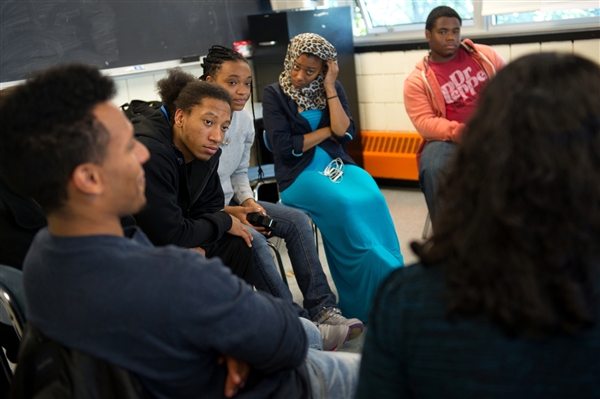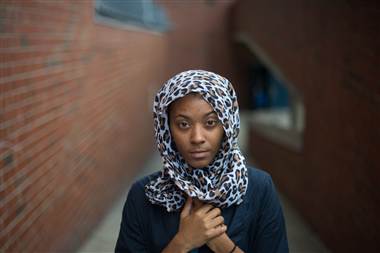Goodbye Zero Tolerance: Program Aims to Cut ‘School-to-Prison Pipeline’
Resource type: News

Students at Charlestown High School in Boston join a discussion circle on Sept. 27, part of Diploma Plus, a restorative justice program that offers at-risk students guidance, conflict resolution and peer mentoring. Photo: Gretchen Ertl for NBC News
By Miranda Leitsinger, Staff Writer, NBC News
BOSTON, Mass. – At Charlestown High School, where many students come from high-crime neighborhoods, an innovative program employs a surprising method to help keep teens in school and out of trouble with the law: Encouraging them to talk to each other.
On one recent Friday, nine students gathered for a weekly discussion circle aimed at creating a tight-knit community in order to prevent and resolve conflict. One student spoke about feeling angry, while another explained that she was lonely at home because her mom is in the hospital. “You guys are so on it,” said Natasha Srivastava, a teacher at the program, which is called Diploma Plus.
Diploma Plus uses tenets of “restorative justice,” a practice gaining popularity in classrooms across the country as an alternative to widespread “zero-tolerance policies” that promote suspension or expulsion of misbehaving students. “The idea behind restorative justice is about building relationships, trust and community so people are invested,” said Janet Connors, coordinator of Diploma Plus’ Justice League, a student-led group that helps resolve disputes.
Restorative justice programs, which include discussion circles and student-led courts, give troubled students a second chance to succeed at school and aim to disrupt the “school-to-prison pipeline,” in which expelled youth end up in the criminal justice system.
In recent decades, the number of youth suspensions and expulsions has dramatically increased across the nation for a wide range of offenses, including minor incidents such as intentionally bumping into someone in a hallway. But serious consequences have followed, said sociologist David Karp, associate dean at Skidmore College and an expert in restorative justice in educational settings.
“Student retention goes down with suspension,” Karp said. For youth pushed out of school, “you just increase the chances that they’ll drop out and that increases the chances they’ll get in trouble with the law.”
But restorative justice programs don’t only benefit the kids, said Karp, they help keep the streets safe, as well as prevent student-on-student violence in the schools. “People recognize that post-Newtown, schools can’t be protected simply through fortification and that we really need other mechanisms that are more trust-building than school police officers and metal detectors,” he said.

Senior Jahni Ferguson, 18, came to Charlestown High from a nearby school that she didn’t like. She says of her experience in the Diploma Plus program: “It’s like more of a family.” Photo: Gretchen Ertl for NBC News
At Charlestown’s Diploma Plus center, students learn how to resolve disputes by addressing the cause of conflict and repairing the harm – such as by writing an apology — rather than by doling out a punishment like detention. In some cases, the Justice League will hear disputes and help craft a deal.
Ryan Gunter, an 18-year-old senior, faced the Justice League in his sophomore year after getting into a classroom dispute with his teacher for not turning in his cell phone, as mandated by the program rules.
After realizing he was wrong, Gunter agreed to turn in his phone for a week – and has done so ever since without fail. “Instead of me getting sent home for the day or getting suspended, I got to stay,” he said.
“I think it definitely changed the way I think about school,” he added, noting he learned there “can be a way out” that doesn’t involve suspension. “We can come up with some type of middle ground or some type of understanding of how we can move forward.”
Boston Public Schools said programs like Charlestown’s were making a difference: The number of arrests of students has plunged from 288 in 2009, the year before implementing practices like restorative justice, to 142 in the past school year.
“We know this works, based not only on the drop in the number of arrests, which represents the most serious offenses, but in the changes we’ve seen in students who would have otherwise been suspended or expelled,” interim superintendent John McDonough said in a statement.
School districts in states like Florida, Texas, Minnesota, Illinois, California and Oregon have crafted their own restorative justice programs. And about 20 schools in Oakland, Calif., and a half dozen in Portland, Ore., with restorative justice programs have experienced drops in student suspensions since educators adopted the approach.
In Oakland, the school district reached a voluntary agreement last year with the U.S. Department of Education’s Office for Civil Rights, which had been investigating the disproportionate numbers of African-American men who were being suspended, to incorporate practices like restorative justice (which it had already begun doing) to eliminate the disparity.
David Yusem, the Oakland district’s program manager for restorative justice, said the alternative approach had been successful and empowering for youth.
But he said that for those accustomed to a “crime and punishment” model, it was a big shift for them to understand that restorative justice was “not soft. It’s actually extremely difficult to be held accountable by repairing harm.”
While experts agreed that schools had experienced success with the approach, they also cautioned it wouldn’t work in every scenario.
“They’re not a cure-all. Restorative justice programs work best when you have a situation where all of the kids involved are motivated to change,” said Elizabeth Englander, director of the Massachusetts Aggression Reduction Center, which researches bullying in K-12 schools.
But bullies may not want to change. Restorative justice is “very successful when they’re used on the right problems. But when they’re used on the wrong problems, they can actually be counterproductive,” she added.
The approach also takes time, and sometimes a punishment like detention is needed. Not every student will succeed, either. That’s why the circle recently led by Srivastava focused on the youth getting to know one another, so they can help each other ward off future problems.
At the end of the circle, they gave “shout outs” to their peers for opening up.
“I believe everybody in the circle deserves a shout out,” said 20-year-old senior David Depina, “because they are showing their true qualities.”
Oakland Unified School District is an Atlantic grantee.